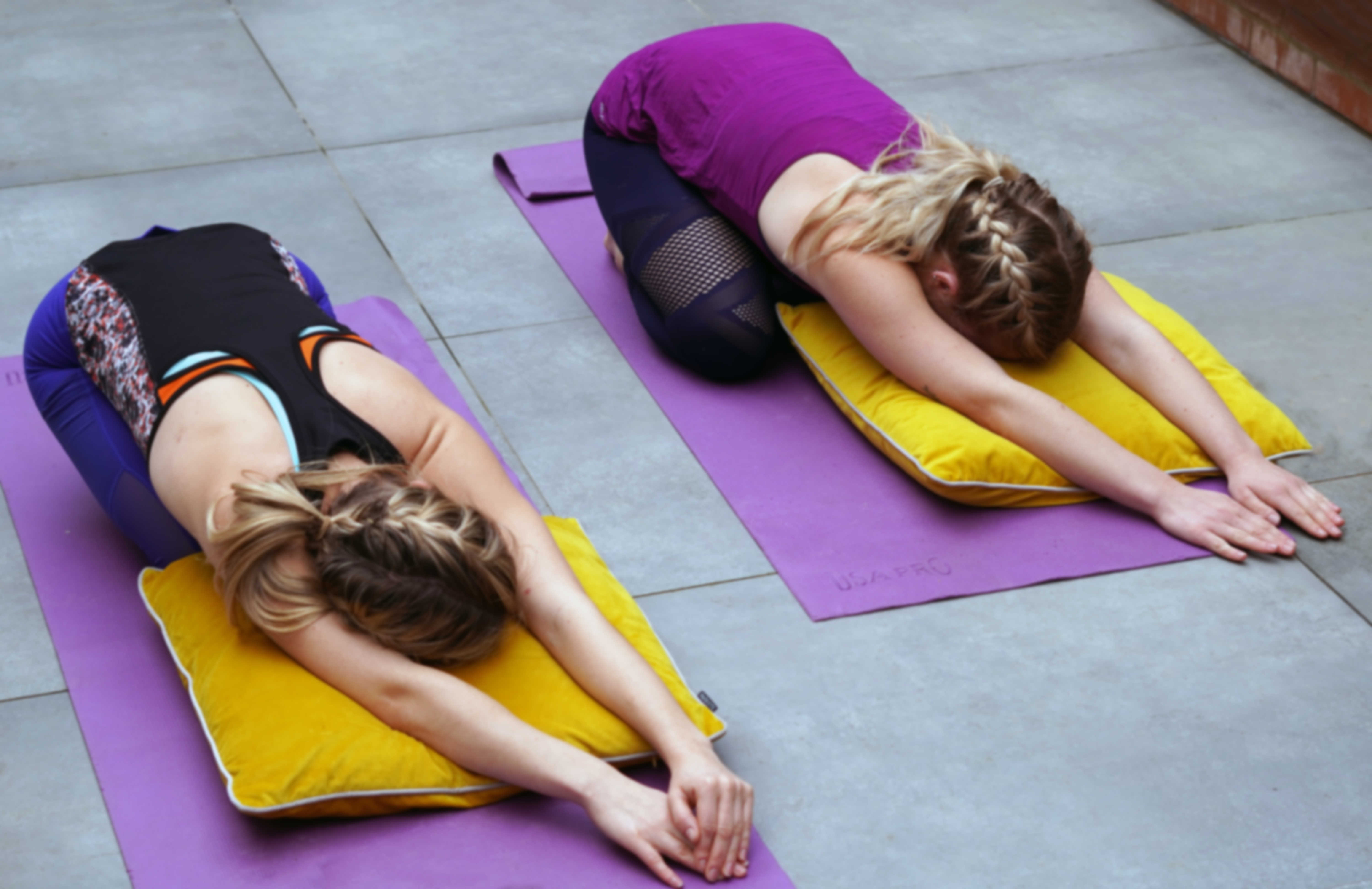** FREE SHIPPING ON ALL PRODUCTS **

Photo: Claudia Avila-Batchelor yoga-for-chronic-pain
6 Beginners’ Yin Yoga Poses to Target Chronic Pain
Yoga is a slow and gentle style of movement exercise involving staying in supported poses (asanas) for a few minutes through to longer periods depending on type. Yoga can be practiced on mats, standing, sitting or lying on the floor and great for calming the nervous system.
What is Yin Yoga?

IPhoto: Claudia Avila-Batchelor yoga-supported-poses
Yin Yoga is a gentle type of Yoga which stretches and releases tension in the underlying fascia – deep connective tissue – that holds our muscles, bones and organs in place. By holding the stretch for longer than usual, the connective tissue is stimulated instead of just the muscles. And the body responds by making this connective tissue slightly longer and stronger.
Yin Yoga poses for Chronic Pain

Claudia Avila-Batchelor release-tension-with-yoga
Connective tissue is especially important to people with chronic pain. It sends the message – from our brain or nervous system – to tell the muscles to contract, often causing or increasing pain. In yin yoga, we combine stretching with slow breathing, with the end goal of encouraging the muscles to slowly relax instead of contract.
Is Yin Yoga uncomfortable?

Claudia Avila-Batchelor yoga-breathing-for-chronic-pain
It’s normal to feel slight discomfort as you ease into the postures – but you should ensure your breath is easy and you feel no burning pain. These yoga poses for chronic pain don’t need any specialist equipment, although you may find a pillow useful. They are best performed as a sequence, lasting around 20 minutes.
1. Modified Child’s Pose

IPhoto: Claudia Avila-Batchelor stretching-spine-muscles
What does the modified child’s pose do?
This classic posture stretches the muscles around the spine, while relieving back and neck tension. Kneel on the floor.

I Claudia Avila-Batchelor relaxing-yoga-for-chronic-pain
Bring your big toes together to touch one another.
Place your knees as wide apart as you’d like.

IPhoto: Claudia Avila-Batchelor alternative-child’s-pose
How is the modified child’s yoga pose for chronic pain different?
Instead of bringing the upper body forwards – like in a traditional child’s pose – bring it down towards the right

IPhoto: Claudia Avila-Batchelor soothe-and-relive-chronic-pain
You could place a pillow underneath your forehead or chest. After 5 minutes, lift the upper body up, move your pillow to the left and drop into the pose on this side.

IPhoto: Claudia Avila-Batchelor yoga-helps-sore-muscles
Contraindications:
If you have knee issues, place a pillow between your legs
2. Half Dragonfly

Photo: Claudia Avila-Batchelor half-dragonfly-yoga-pose
Benefits of the Half Dragonfly position
The half dragonfly releases tension in the shoulders and upper body with this yin position. It can also reduce the pain associated with frozen shoulder.

Photo: Claudia Avila-Batchelor release-the-pressure
How to get into the Half Dragonfly position
Lie on your left side, with your left arm straight out in front of you.
Roll slowly onto your front, so your chest is resting on your left arm.
Rest your forehead on the floor or prop it up with a pillow – whichever feels most comfortable.
Reach your right arm up, so it’s next to your head.
Press your right palm towards the ground.

IPhoto: Claudia Avila-Batchelor relaxing-through-yoga
Ensure your legs are relaxed and a comfortable distance apart.
Hold for 3 minutes, before repeating on your left side.

Photo: Claudia Avila-Batchelor careful-poses-to-avoid-injury
Roll back onto your side and carefully sit up.
Contraindications:
It’s best to elevate your hips with a pillow, if you suffer from sciatica.
3. Butterfly

IPhoto: Claudia Avila-Batchelor yoga-butterfly-pose
Relieve tightness of the lower back and hip flexors with this forward fold.
How to get into butterfly position

Image by via.placeholder.com
From a seated position, bring the soles of your feet together and then slide them away from you.

Photo: Claudia Avila-Batchelor forward-back-stretch
Allow your back to round, while you fold forward.
Rest your hands on your feet.
Your head should hang down towards your heels.

Photo: Claudia Avila-Batchelor protect-your-neck
Hold for 5 minutes.
Slowly ease your head back up into its usual position.

Claudia Avila-Batchelor contraindication-for-whiplash
Butterfly Contraindications:
Avoid dropping your head, if you’ve recently suffered whiplash.
Elevate your hips by sitting on a pillow, if you have sciatica.
4. Reclined Butterfly

Photo: Claudia Avila-Batchelor reclined-butterfly-yoga-pose
This soothing pose gently stretches the inner thighs, hips and knees.
Lie down onto a pillow, ensuring it’s positioned under your rib cage.

Photo: Claudia Avila-Batchelor open-legs-stretch
Bring the soles of your feet together.
Place the feet as close to your body as comfortable, with your knees open wide.

IPhoto: Claudia Avila-Batchelor neck-stretch-for-pain
Ensure the top of your head, hips and sides of your feet are lying against the floor.

Photo: Claudia Avila-Batchelor yoga-relief-for-sore-muscles
Additional stretch for Reclined Butterfly:
For an extra stretch in the shoulders and chest, rest your hands on your stomach or hold opposite elbows above the head.
Hold for 5 minutes. Release your legs, roll carefully onto your side and slowly sit up.

Image by via.placeholder.com
Contraindications of Reclining Butterfly:
If you have a groin or knee injury, perform this pose with pillows under the outer thighs.
5. Reclined Spinal Twist

Photo: Claudia Avila-Batchelor reclined-spinal-twist
The why and how of the reclined spinal twist
Twisting postures can be a relaxing way to release tension around the spine, while helping to restore its natural range of motion.
Lie on your back.
Draw both knees into your chest.

Photo: Claudia Avila-Batchelor yoga-for-sore-joints
Open your arms to the side, so they’re at a right angle to your body.

Photo: Claudia Avila-Batchelor spinal-twist-for-pain-relief
Drop your knees to the right.

IPhoto: Claudia Avila-Batchelor yoga-breathing
Hold for 3 minutes, before repeating on your left side.

IPhoto: Claudia Avila-Batchelor natural-pain-relief
Reclined Spinal Twist for sciatica:
Direct the knees lower or higher to impact on where in the spine the stretch is felt.
For sciatica pain relief, bring the bent knee towards the chest.

Photo: Claudia Avila-Batchelor relaxing-stretch
Contraindications:
People with shoulder issues may find it more comfortable to bend their arms.
6. Shavasana

Claudia Avila-Batchelor shavasana-pose
What is Shavasana
Shavasana rests the body and mind. It should be the final pose in any yin yoga sequence.
Lie on your back and place your arms to the side with your palms facing upwards.

Photo: Claudia Avila-Batchelor yoga-breathing-to-relieve-pain
Breath and Shavasana:
Pay attention to your breath.
Slowly scan your body, noting how each body part feels.
Hold for 3 to 5 minutes.

IPhoto: Claudia Avila-Batchelor side-push-up
Slowly roll onto your side and push yourself up as it’s important to be measured when you are practising yoga poses for chronic pain.

IPhoto: Claudia Avila-Batchelor shavasana-with-support
Expert Bio:
Rebecca Tidy is a qualified yoga instructor. She originally learned yoga to help reduce her own chronic pain, caused by cancer treatment.
Now, she loves helping others reduce their discomfort, while increasing mobility..
It’s always wise to chat to a doctor before beginning any exercise programme, especially if you have any serious health issues or may be pregnant.
25 years of wisdom and heritage
Continue reading

Hemp Seed Oil Skincare: Why your skin needs hemp
Hemp seed oil skincare has been here a long time and its benefits just keep on growing! Add cannabis seed oil to your skincare routine.

What are terpenes? An inside look at the cannabis plant
Terpenes make as much difference to the therapeutic benefits of plants as cannabinoids. We explore what terpenes are and what they offer.

5 Ways to Bring CBD Self Care into Your Life
Want to enjoy a little CBD self care? We’ve covered all of your favourite CBD products here to help you bring CBD rituals into your life.

Dermactiva was created using over 25 years of wisdom and heritage from Herman Patiño’s proven base product, using certified Organic Cannabis Sativa Oil.



